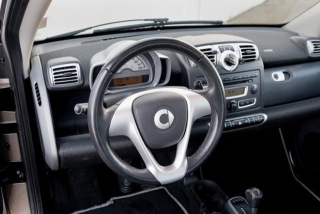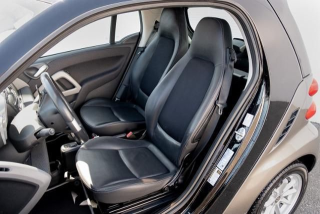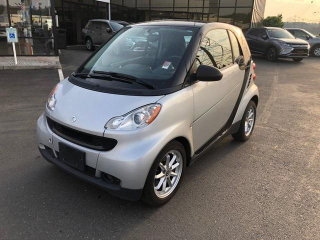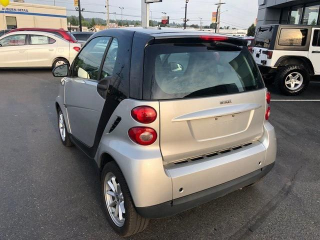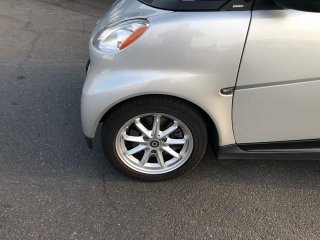The 2009 Smart Fortwo, a subcompact city car, made its debut in the U.S. for the 2008 model year. Primarily offered as a two-door coupe, it also had a convertible variant. For 2009, key trims included the Pure, Passion, and Grandstyle. New pricing ranged from approximately $12,000 to $17,000. Its standout feature is its exceptionally small size, making it incredibly maneuverable and easy to park in urban environments, a major reason for its popularity among city dwellers.
The Good
The 2009 Smart Fortwo excels in urban agility, unparalleled parking ease, and remarkable fuel efficiency. Its quirky, distinctive design appeals emotionally, while its low running costs and practicality satisfy pragmatic buyers.
The Bad
Potential buyers should be aware of its weak acceleration, the polarizing automated manual transmission's jerky shifts, limited cargo space, and subpar crash test performance in certain areas. Long-term reliability concerns and a lack of dealer support in some regions are also worth noting.
2009 Smart fortwo: Quick Overview
- Engine Options: The 2009 Smart Fortwo came standard with a 1.0-liter, three-cylinder gasoline engine.
- Horsepower: This engine produced 70 horsepower.
- Fuel Economy: Estimated fuel economy was around 33 mpg city and 39 mpg highway, making it very efficient for city driving.
- 0-60 Times: Acceleration was not a strong suit, with 0-60 mph times typically in the 13-15 second range, depending on conditions and driver input.
- Towing Capacity: The Smart Fortwo is not designed for towing; it has no towing capacity.
- Trim-Level Features:
- Pure: The base trim offered essential features like power windows, air conditioning, and a basic sound system.
- Passion: This trim added alloy wheels, a panoramic glass roof (coupe), a more premium sound system, keyless entry, and an upgraded interior trim.
- Grandstyle: Often a limited edition or package, it typically included unique styling elements, premium upholstery, and enhanced comfort features, building upon the Passion trim.
2009 Smart fortwo Specifications
Vehicle Information
| Year | 2009 |
| Make | Smart |
| Model | fortwo |
| Trim | - |
| Style | - |
| Type | Sport Utility Vehicle Mini Coupe |
| Category | Sports Car Compact Car |
Manufacturing Details
| Made In | Germany |
| Manufacturing City | HAMBACH |
Dimensions
| Doors | 2-Door |
| Curb Weight | - |
| Gross Vehicle Weight Rating | - |
| Overall Height | - |
| Overall Length | - |
| Overall Width | - |
| Wheelbase Length | - |
| Standard Seating | - |
Engine & Performance
| Engine | 1.0L L3 |
| Engine Size | 1L |
| Engine Cylinders | 3 |
| Transmission | - |
| Transmission Type | - |
| Transmission Speeds | - |
| Drivetrain | Rear-Wheel Drive |
Additional Features
| Anti-Brake System | - |
| Steering Type | - |
Pricing
| Manufacturer Suggested Retail Price (MSRP) | - |
| Invoice Price | - |
| Delivery Charges | - |
Vehicle History Report
Vehicle
Specifications
Specifications
Ownership
History
History
All History
Events
Events
NMVTIS Title
History Check
History Check
Salvage/Rebuilt
Check
Check
Accident
Check
Check
Theft
Check
Check
Open Lien
Check
Check
Past Sale
Listings
Listings
Safety
Recalls
Recalls
Odometer
Check
Check
Market Price
Analysis
Analysis
What Problems Does the 2009 Smart fortwo Have?
The 2009 Smart Fortwo, while charming for its size, has several commonly reported issues and long-term reliability concerns that potential buyers should be aware of. One of the most frequently cited problems revolves around the automated manual transmission, often referred to as a semi-automatic. Owners frequently report jerky shifts, hesitation, and an overall clunky driving experience, especially at lower speeds or when attempting to accelerate quickly. This transmission system is a significant departure from conventional automatic transmissions and can be a source of frustration for many drivers.
Another area of concern for the 2009 model year relates to electrical gremlins. Issues with the power windows, central locking system, and dashboard warning lights have been reported. Some owners have also experienced problems with the air conditioning system, leading to premature failure or insufficient cooling. While not exclusive to the 2009 model, the Smart Fortwo's small size and unique construction can sometimes make certain repairs more complex and potentially costly, especially if specialized tools or knowledge are required.
In terms of recalls, specific to the 2009 model year, there have been recalls related to the braking system, specifically potential issues with the brake fluid reservoir. It is crucial for prospective buyers to verify if any outstanding recalls have been addressed on the specific vehicle they are considering. Long-term reliability can be a mixed bag; while the powertrain is generally robust for its intended use, the aforementioned transmission and electrical issues can detract from the ownership experience over time. The lack of a widespread dealer network compared to mainstream manufacturers can also make sourcing parts and finding qualified mechanics a challenge in some areas, potentially impacting long-term ownership.
Another area of concern for the 2009 model year relates to electrical gremlins. Issues with the power windows, central locking system, and dashboard warning lights have been reported. Some owners have also experienced problems with the air conditioning system, leading to premature failure or insufficient cooling. While not exclusive to the 2009 model, the Smart Fortwo's small size and unique construction can sometimes make certain repairs more complex and potentially costly, especially if specialized tools or knowledge are required.
In terms of recalls, specific to the 2009 model year, there have been recalls related to the braking system, specifically potential issues with the brake fluid reservoir. It is crucial for prospective buyers to verify if any outstanding recalls have been addressed on the specific vehicle they are considering. Long-term reliability can be a mixed bag; while the powertrain is generally robust for its intended use, the aforementioned transmission and electrical issues can detract from the ownership experience over time. The lack of a widespread dealer network compared to mainstream manufacturers can also make sourcing parts and finding qualified mechanics a challenge in some areas, potentially impacting long-term ownership.
How long will the 2009 Smart fortwo last?
Based on owner data and maintenance habits, the 2009 Smart Fortwo can typically achieve between 150,000 to 200,000 miles of service life. Regular maintenance, especially focusing on fluid changes and timely attention to any reported transmission issues, is crucial for maximizing its lifespan. The powertrain, a 1.0-liter engine, is generally durable for its size and intended city use. However, the long-term durability is significantly influenced by how well the automated manual transmission is maintained and whether its inherent quirks are tolerated. Over time, electrical components and seals can become weak points, so diligent inspection of these areas is recommended for older models. Neglecting maintenance, particularly transmission fluid, can lead to accelerated wear and more significant repair costs.
What Technology & Safety Features are Included?
The 2009 Smart Fortwo's technology and safety features were modest, reflecting its compact, city-focused design. For tech and entertainment, standard equipment typically included a basic audio system with an AM/FM radio and CD player. Higher trims, like the Passion, often came with an upgraded sound system, possibly with more speakers, and sometimes offered an optional auxiliary input for connecting external music devices. Bluetooth connectivity and navigation systems were generally not standard or widely available options for this model year.
Driver-assistance features were very limited. The primary assistance feature was simply the car's small size and excellent maneuverability, making it easy to navigate tight spaces and park. Anti-lock brakes (ABS) were standard across all trims, providing essential braking control. Traction control was also typically included, helping to maintain stability on slippery surfaces. Electronic stability control was generally not a standard feature on the 2009 model, which is a notable omission compared to more contemporary vehicles.
In terms of safety, the 2009 Smart Fortwo came equipped with front airbags for the driver and passenger, and side airbags were often standard or part of optional packages on higher trims. The vehicle's structure was designed to absorb impact energy, though its small size presented inherent challenges in larger-impact collisions. Regarding crash-test ratings, the 2009 Smart Fortwo received mixed results from the Insurance Institute for Highway Safety (IIHS). It earned a 'Good' rating in frontal offset impact tests, which was a positive. However, it received 'Acceptable' ratings in side impact tests and 'Marginal' in rear impact tests. These ratings underscored the compromises made for its ultra-compact design, particularly in more severe collision scenarios.
Driver-assistance features were very limited. The primary assistance feature was simply the car's small size and excellent maneuverability, making it easy to navigate tight spaces and park. Anti-lock brakes (ABS) were standard across all trims, providing essential braking control. Traction control was also typically included, helping to maintain stability on slippery surfaces. Electronic stability control was generally not a standard feature on the 2009 model, which is a notable omission compared to more contemporary vehicles.
In terms of safety, the 2009 Smart Fortwo came equipped with front airbags for the driver and passenger, and side airbags were often standard or part of optional packages on higher trims. The vehicle's structure was designed to absorb impact energy, though its small size presented inherent challenges in larger-impact collisions. Regarding crash-test ratings, the 2009 Smart Fortwo received mixed results from the Insurance Institute for Highway Safety (IIHS). It earned a 'Good' rating in frontal offset impact tests, which was a positive. However, it received 'Acceptable' ratings in side impact tests and 'Marginal' in rear impact tests. These ratings underscored the compromises made for its ultra-compact design, particularly in more severe collision scenarios.
What Colors Options are Available?
Exterior Colors
Silver Metallic
Black
White
Red
Blue Metallic
Anthracite
Orange
Interior Colors
Gray Interior
Black Interior
White Interior
2009 Smart fortwo Prices and Market Value
When new, the 2009 Smart Fortwo had a Manufacturer's Suggested Retail Price (MSRP) that typically ranged from around $12,000 for the base Pure coupe to approximately $17,000 for the more equipped Passion models and convertible variants. Today, the used market prices for a 2009 Smart Fortwo are significantly lower, generally falling between $3,000 and $7,000, depending heavily on mileage, condition, trim level, and overall maintenance history. The Smart Fortwo experiences a relatively steep depreciation curve, common for niche vehicles with unique characteristics. Factors affecting resale value include its quirky appeal, which can be polarizing, the availability of parts and service, and the vehicle's overall mileage and condition, with well-maintained examples commanding higher prices within its limited market segment.
2009 Smart fortwo Cost of Ownership
The 2009 Smart Fortwo is generally considered economical to own, especially concerning fuel and insurance. Its small engine and lightweight construction result in excellent fuel efficiency, keeping gas costs low. Insurance premiums are typically affordable due to its low base price and reduced risk profile. Maintenance costs can be moderate, with routine services being reasonable. However, repairs, particularly for its specialized components or transmission, can sometimes be more costly than for mainstream compact cars due to fewer independent repair shops and potentially higher parts prices. Despite occasional repair expenses, its overall low running costs make it an economical choice for city driving.
2009 Smart fortwo Fuel Efficiency
Fuel Type
Gasoline
Fuel Capacity
-
City Mileage
-
Highway Mileage
-
2009 Smart fortwo Safety Rating
NHTSA
2009 Smart fortwo Recalls & Defects
Engine and Engine Cooling:engine
Recall date
2018-04-27
Recall no.
18v273000
Source
NHTSA
Summary
Mercedes-Benz Usa, Llc. (Mbusa) IS Recalling Certain 2008-2009 Smart Fortwo Cabrio and Fortwo Coupe Vehicles. THE Rear Insulation MAT IN THE Engine Compartment MAY Deform, Deteriorate, and Loosen Over Time, Allowing THE MAT TO Contact HOT Exhaust System Components.
Consequence
IF THE MAT Contacts HOT Exhaust System Components, IT CAN Increase THE Risk OF A Fire.
Remedy
Mbusa Will Notify Owners, and Dealers Will Replace THE Rear Insulation MAT With AN Improved One, Free OF Charge. THE Recall Began IN July 2018. Owners MAY Contact Mbusa Customer Service AT 1-800-367-6372. Mbusa's Number FOR This Recall IS 2018060010.
Notes
Owners MAY Also Contact THE National Highway Traffic Safety Administration Vehicle Safety Hotline AT 1-888-327-4236 (Tty 1-800-424-9153), or GO TO Www.safercar.gov.
Engine and Engine Cooling:exhaust System
Recall date
2018-04-27
Recall no.
18v273000
Source
NHTSA
Summary
Mercedes-Benz Usa, Llc. (Mbusa) IS Recalling Certain 2008-2009 Smart Fortwo Cabrio and Fortwo Coupe Vehicles. THE Rear Insulation MAT IN THE Engine Compartment MAY Deform, Deteriorate, and Loosen Over Time, Allowing THE MAT TO Contact HOT Exhaust System Components.
Consequence
IF THE MAT Contacts HOT Exhaust System Components, IT CAN Increase THE Risk OF A Fire.
Remedy
Mbusa Will Notify Owners, and Dealers Will Replace THE Rear Insulation MAT With AN Improved One, Free OF Charge. THE Recall Began IN July 2018. Owners MAY Contact Mbusa Customer Service AT 1-800-367-6372. Mbusa's Number FOR This Recall IS 2018060010.
Notes
Owners MAY Also Contact THE National Highway Traffic Safety Administration Vehicle Safety Hotline AT 1-888-327-4236 (Tty 1-800-424-9153), or GO TO Www.safercar.gov.
2009 Smart fortwo Insurance
Insurance for a 2009 Smart fortwo is moderately priced, reflecting its status as a Sport Utility Vehicle Mini Coupe with strong safety ratings and
reasonable repair costs.
reasonable repair costs.
How Does the 2009 Smart fortwo Compare to Other Sport Utility Vehicle Mini Coupe?
The 2009 Smart Fortwo occupies a unique niche, making direct comparisons challenging. Its primary rivals were other ultra-compact city cars and some entry-level subcompacts, though few matched its extreme dimensions. In terms of performance, the Smart Fortwo lagged significantly behind most competitors. Its 70-horsepower engine and automated manual transmission provided sluggish acceleration, with 0-60 mph times around 13-15 seconds, whereas rivals like the Honda Fit or Toyota Yaris offered more sprightly performance with comparable or better fuel economy.
Feature-wise, the Smart Fortwo was basic, especially in its lower trims. While it offered essential creature comforts like air conditioning, higher trims had some nice additions like a panoramic roof. However, it lacked the advanced infotainment systems, comprehensive safety suites (like standard ESC), and interior refinement found in competitors such as the Mini Cooper or even more mainstream options like the Fiat 500 (in later years) or the aforementioned Honda Fit and Toyota Yaris. These rivals often offered more spacious interiors and better cargo capacity.
Reliability is a mixed bag for the Smart Fortwo. While the engine itself is generally robust for its intended use, the automated manual transmission is a known weak point with frequent reports of harsh shifting and potential long-term issues. Mainstream Japanese and Korean competitors often boast superior long-term reliability records and fewer known recurring problems.
In terms of price, the Smart Fortwo was often priced competitively when new, especially considering its unique selling proposition. However, its used market value depreciates rapidly, making it very affordable. Better or similar alternatives depend on priorities. For those prioritizing pure city maneuverability and parking ease above all else, the Smart Fortwo remains unique. However, if performance, a more conventional driving experience, better reliability, or more modern features are desired, alternatives like the Honda Fit, Toyota Yaris, or Mini Cooper (though pricier) are generally superior choices offering a more balanced package.
Feature-wise, the Smart Fortwo was basic, especially in its lower trims. While it offered essential creature comforts like air conditioning, higher trims had some nice additions like a panoramic roof. However, it lacked the advanced infotainment systems, comprehensive safety suites (like standard ESC), and interior refinement found in competitors such as the Mini Cooper or even more mainstream options like the Fiat 500 (in later years) or the aforementioned Honda Fit and Toyota Yaris. These rivals often offered more spacious interiors and better cargo capacity.
Reliability is a mixed bag for the Smart Fortwo. While the engine itself is generally robust for its intended use, the automated manual transmission is a known weak point with frequent reports of harsh shifting and potential long-term issues. Mainstream Japanese and Korean competitors often boast superior long-term reliability records and fewer known recurring problems.
In terms of price, the Smart Fortwo was often priced competitively when new, especially considering its unique selling proposition. However, its used market value depreciates rapidly, making it very affordable. Better or similar alternatives depend on priorities. For those prioritizing pure city maneuverability and parking ease above all else, the Smart Fortwo remains unique. However, if performance, a more conventional driving experience, better reliability, or more modern features are desired, alternatives like the Honda Fit, Toyota Yaris, or Mini Cooper (though pricier) are generally superior choices offering a more balanced package.
Final Verdict: Is the 2009 Smart fortwo a Good Sport Utility Vehicle Mini Coupe?
The 2009 Smart Fortwo is ideal for urban dwellers with very limited parking space and a need for an exceptionally maneuverable vehicle. It's best suited for individuals who prioritize ease of parking and fuel efficiency over spirited performance or extensive cargo capacity. It is worth considering as a second car for city commuting, especially if purchased at a low used price. However, its significant weaknesses, including a clunky transmission, lack of power, and somewhat compromised safety ratings compared to larger vehicles, mean it's not suitable for everyone. Buying used is the only practical option today. Specific trims like the Passion offer more creature comforts, but the core driving experience remains similar. Thorough inspection, particularly of the transmission and electrical systems, is crucial before purchasing.
